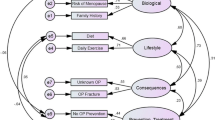Abstract
Summary
In older women, knowledge about risk factors for osteoporosis was good, with over 75% responding correctly to questions about lifestyle factors, family history, height loss, and menopausal status. However, significant knowledge deficits were identified regarding osteoporosis “consequences” and “prevention and treatment.”
Introduction
We examined osteoporosis knowledge by testing the psychometric properties of the 10-item knowledge component of the “Osteoporosis and You” questionnaire. Several knowledge domains were hypothesized.
Methods
Community-dwelling women aged 65–90 years residing within two regions of Ontario, Canada were studied (N = 869). Data were collected by standardized telephone interviews in 2003 and 2004. Items to which 75% or more responded correctly were identified as having a low index of difficulty; the remaining items identified areas of knowledge deficit. Confirmatory factor analysis was used to test scale structure.
Results
Six of the ten items had a low index of difficulty. These items largely examined osteoporosis risk factors. The remaining four items identified significant knowledge deficits in the areas of osteoporosis consequences, prevention, and treatment. Confirmatory factor analysis identified four distinct osteoporosis knowledge domains. However, the internal consistency was low for all but one domain, which examined “prevention and treatment.”
Conclusion
Although older women appear to be aware of osteoporosis risk factors, knowledge deficits regarding the consequences of osteoporosis and that treatment exists to prevent bone loss were identified. Better understanding of the multi-dimensional aspects of osteoporosis knowledge may help to inform the development of effective educational interventions.
Similar content being viewed by others
References
Andersen RM (1995) Revisiting the behavioral model and access to medical care: Does it matter? J Health Soc Behav 36:1–10
Glanz K, Rimer BK, Lewis FM (2002) Health behavior and health education: theory, research, and practice. Jossey-Bass, San Francisco
Werner P (2005) Knowledge about osteoporosis: assessment, correlates and outcomes. Osteoporos Int 16:115–127
Brenneman SK, Blau EM, Chen Y et al (2002) Validation of a patient questionnaire, ‘Osteoporosis and You’, designed to assess osteoporosis-related attitudes, knowledge and behavior [abstract]. J Bone Miner Res 17 [Suppl 1]:S466
Hawker GA, Wright JG, Coyte PC et al (2000) Differences between men and women in the rate of use of hip and knee arthroplasty. New Engl J Med 342:1016–1022
Cadarette SM, Jaglal SB, Hawker GA (2005) Fracture prevalence and treatment with bone-sparing agents: are there urban-rural differences? A population based study in Ontario, Canada. J Rheumatol 32:550–558
Cadarette SM, Beaton DE, Gignac MAM et al (2006) Inequities in access to osteoporosis investigation and treatment among older community-dwelling women in Ontario, Canada [abstract]. J Bone Miner Res 21 [Suppl 1]:S273
Burgener M, Arnold M, Katz JN et al (2005) Older adults’ knowledge and beliefs about osteoporosis: results of semistructured interviews used for the development of educational materials. J Rheumatol 32:673–677
Kim K, Horan M, Gendler P (1991) Osteoporosis Health Belief Scale. Grand Valley State University, Allendale
Cadarette SM, Beaton DE, Hawker GA (2004) Osteoporosis Health Belief Scale: minor changes were required after telephone administration among women. J Clin Epidemiol 57:154–166
Kim K, Horan M, Gendler P (1991) Osteoporosis Knowledge Test. Grand Valley State University, Allendale
Winzenberg TM, Oldenburg B, Frendin S et al (2003) The design of a valid and reliable questionnaire to measure osteoporosis knowledge in women: the Osteoporosis Knowledge Assessment Tool (OKAT). BMC Musculoskelet Disord 4:17
Nunnally JC, Bernstein IH (1994) Psychometric theory. McGraw-Hill, Toronto
Jöreskog KG, Sörbom D (1981–2005) PRELIS. Scientific Software International, Lincolnwood
Hair JF, Anderson RE, Tatham RL et al (1998) Multivariate data analysis. Prentice Hall, Upper Saddle River
Jöreskog KG, Sörbom D (2005) LISREL. Scientific Software International, Lincolnwood
Hatcher L (1994) A step-by-step approach to using the SAS System for factor analysis and structural equation modeling. SAS Institute, Cary
Kline RB (2005) Principles and practice of structural equation modeling. Guilford Press, New York
DeVellis RF (2003) Scale development: theory and applications. Sage, Thousand Oaks
Solomon DH, Finkelstein JS, Polinski JM et al (2006) A randomized controlled trial of mailed osteoporosis education to older adults. Osteoporos Int 17:760–767
Wilkins K (2003) Social support and mortality in seniors. Health Rep 14:21–34
Wilkins K, Park E (1996) Chronic conditions, physical limitations and dependency among seniors living in the community. Health Rep 8:7–15
Statistics Canada (1999) Health among older adults. Health Rep 11:47–61
Statistics Canada (2002) 2001 Community profiles. Statistics Canada catalogue No. 93F0053XIE. http://www12.statcan.ca/english/Profil01/CP01/Index.cfm?Lang=E
Acknowledgements
This research was funded by the Canadian Institutes of Health Research (CIHR). Dr. Cadarette was supported by a Doctoral Research Award from CIHR in partnership with the Ontario Ministry of Health and Long-Term Care, a Naomi Grigg Fellowship for Post-Graduate Studies in Gerontology from the Soroptimist International of Toronto, and as an Ontario Women’s Health Doctoral Scholar, and is currently a CIHR Post-Doctoral Fellow. Dr. Beaton is a CIHR New Investigator, Dr. Jaglal is the Toronto Rehabilitation Institute Chair at the University of Toronto, and Dr. Hawker is the FM Hill Chair in Academic Women’s Medicine at the University of Toronto.
Author information
Authors and Affiliations
Corresponding author
Glossary
- Domain
-
An underlying trait (latent variable, hypothetical construct or attribute) that cannot be measure directly, but can be inferred from multiple items supposedly based upon it
- Factor
-
Domain in reference to factor analysis (statistical method employed to determine scale structure), indicating items that are grouped together based on a similar distribution of responses
- Item
-
A single question aiming to tap into an aspect of an underlying domain
- Scale
-
Multi-item questionnaire designed to measure at least one domain.
Rights and permissions
About this article
Cite this article
Cadarette, S.M., Gignac, M.A.M., Beaton, D.E. et al. Psychometric properties of the “Osteoporosis and You” questionnaire: osteoporosis knowledge deficits among older community-dwelling women. Osteoporos Int 18, 981–989 (2007). https://doi.org/10.1007/s00198-007-0326-z
Received:
Accepted:
Published:
Issue Date:
DOI: https://doi.org/10.1007/s00198-007-0326-z




